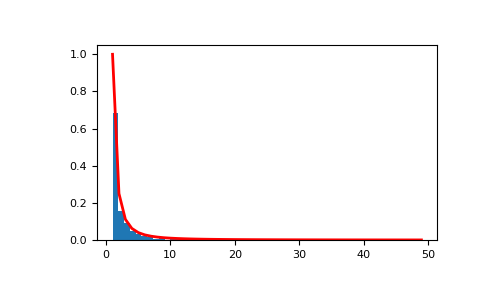numpy.random.Generator.zipf¶
method
- random.Generator.zipf(a, size=None)¶
Draw samples from a Zipf distribution.
Samples are drawn from a Zipf distribution with specified parameter a > 1.
The Zipf distribution (also known as the zeta distribution) is a continuous probability distribution that satisfies Zipf’s law: the frequency of an item is inversely proportional to its rank in a frequency table.
- Parameters
- afloat or array_like of floats
Distribution parameter. Must be greater than 1.
- sizeint or tuple of ints, optional
Output shape. If the given shape is, e.g.,
(m, n, k), thenm * n * ksamples are drawn. If size isNone(default), a single value is returned ifais a scalar. Otherwise,np.array(a).sizesamples are drawn.
- Returns
- outndarray or scalar
Drawn samples from the parameterized Zipf distribution.
See also
scipy.stats.zipfprobability density function, distribution, or cumulative density function, etc.
Notes
The probability density for the Zipf distribution is
\[p(x) = \frac{x^{-a}}{\zeta(a)},\]where \(\zeta\) is the Riemann Zeta function.
It is named for the American linguist George Kingsley Zipf, who noted that the frequency of any word in a sample of a language is inversely proportional to its rank in the frequency table.
References
- 1
Zipf, G. K., “Selected Studies of the Principle of Relative Frequency in Language,” Cambridge, MA: Harvard Univ. Press, 1932.
Examples
Draw samples from the distribution:
>>> a = 2. # parameter >>> s = np.random.default_rng().zipf(a, 1000)
Display the histogram of the samples, along with the probability density function:
>>> import matplotlib.pyplot as plt >>> from scipy import special
Truncate s values at 50 so plot is interesting:
>>> count, bins, ignored = plt.hist(s[s<50], ... 50, density=True) >>> x = np.arange(1., 50.) >>> y = x**(-a) / special.zetac(a) >>> plt.plot(x, y/max(y), linewidth=2, color='r') >>> plt.show()
